how to draw rubik's cube 3d drawings
How to Solve The Rubik's Cube
If you're reading this, yous're probably holding a cube in your manus and already feeling bad about yourself for needing to look up the solution. Simply don't worry! In fact, most of the "super-human-intelligence beings" (a common misconception) who have solved the cube thousands of times in their lifetimes were sitting equally you are now. Whether you want to larn it to impress a daughter, because your friends bet y'all couldn't, or but to close the volume on the biggest time waste product of your babyhood by finally defeating it, this guide will take you through the simplest mode to conquer the puzzle.
The necessary steps are listed below. Click on a cube to jump on the page to the selected affiliate:
An important thing to note is that this task is non a calorie-free i. It may crave several hours of attempts. If you'd rather only solve the cube in your hand and forget about it rather than being able to solve any cube you're given, there are plenty of solvers available on the web. However, the satisfaction of holding a completed Rubik's Cube in your hand and thinking "I did that, and I can do it again" is greater than almost, mainly due to the fact that the puzzle has been present in all our lives at some signal. Past the mid 1980's, an estimated fifth of the world's population had attempted to solve the cube. If y'all desire to stand out and say that you lot can defeat the puzzle, time and determination is a large gene.
Notation
If you're however reading, congratulations on not beingness put off by the time requirements! The start thing y'all are going to need to know about solving the cube is how the turns y'all make can be represented by messages. After in this guide, y'all're going to need a few algorithms. These are combinations of moves that rotate pieces or just motility them around to get them where you desire them. These algorithms are written using this notation, so you tin e'er come back to this department if yous've forgotten by the fourth dimension nosotros demand them.
There are six sides on the puzzle, referred to as faces, all of which can be turned individually: Upwards, Down, Left, Right, Front and Back.

Up – Down – Left – Right – Front – Back
The annotation for each of these is U, D, 50, R, F and B respectively. These faces tin be turned in three unlike ways/directions, however. These are:
- U – Refers to a clockwise quarter turn of the upper face.
- U' – Refers to a counter-clockwise quarter turn of the upper face
- U2 – Refers to a half turn in either direction of the upper face up.
That's it! For a visualisation of each of these turns, click the messages in the animation widget.
In that location is an advanced notation which includes turns of the middle layers, rotations and "double" turns, merely these aren't needed for this guide. If you're notwithstanding interested in learning them, check them out in the advanced Rubik's notation.
Effort it yourself! Take your cube and perform the following short algorithm: U' L R2 D B' F U2 R'
The left, dorsum, and lower faces might be confusing at first when trying to figure out the clockwise management, simply with a little exercise you'll get used to it.
Step 1: The Cantankerous
The cross is the get-go step in the actual solution of the puzzle. This footstep can be a chip confusing at get-go, so make sure you read this a few times whilst attempting it yourself. The image shows the end goal of this step.
The heart pieces on each face, as yous may have noticed from playing around with the cube, can't be moved to some other spot, only rotated. So we can use this to our reward by building around the centres. The best centre to build your outset cross around is the white centre, as many guides and resources on the spider web showtime with a white face, so if you need to await upward some steps and examples elsewhere, your cube will wait similar to the one that is existence used in other demonstrations.
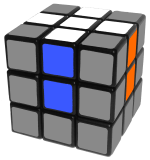
The showtime thing you desire to do is get the white plus on top. Y'all don't need to worry most the matching centres (the orangish and blue parts of the higher up image) simply nonetheless.
For now, just go each white edge on the pinnacle layer. It doesn't matter if the white bit is on top at the moment. For example, your cube could look similar the one pictured. It doesn't thing if all of the white bits are facing up or none of them are.
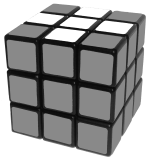
The next step is to flip some of the edges so all of the white stickers confront upwards, making a plus (pictured in a higher place). If your cube already has the cantankerous, skip this role. Hold the cube and then that i of the edges that needs to exist flipped is facing you.
Then utilize this algorithm: F R' D' R F2
This algorithm will flip the edge so the white function is facing upwards. Do this for every edge until you have a white cantankerous on summit.
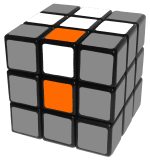
Now you need to orient these pieces. Refer to the adjacent picture. As y'all can see, the orange slice matches the orange centre. Look at the edges on your puzzle. You could have none matching, 2 matching or all matching. If yous have all four edges matching the centres, your cross is solved. If you have none matching, perform a U motion, so look around the cube over again. You want to have at least ii matching. If none of them friction match, exercise another U move. Repeat until you have either 2 or 4 edges matching their centres.
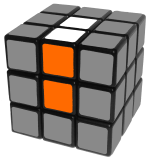
Your goal is to take all four edges matching their centres. If yous have this, then the cross is solved. If y'all have only two, then you could have 1 of two cases. Either the two matching edges are side by side (side by side to each other) or contrary each other. If they are adjacent, hold the cube so that the two solved pieces are facing the front end and left of the cube (shown in the left movie), then perform:
R' U R U' R'
If the ii matching edges are reverse one some other, concord the cube so that they are on the left and right faces (shown in the correct picture) and perform the following algorithm to swap the one in the back and in the front:
R2 L2 U2 R2 L2
Your cross is at present solved!
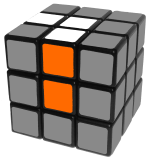
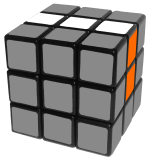
Step 2: The White Corners
Now you lot've done the edges on the white face, all that's left are the corners. This step is much simpler, as it only requires 1 algorithm. The moving picture shows the end goal of this pace.
Await on the bottom layer of the puzzle. You're looking for the white-orange-green corner. There is a l% chance it will be on the lesser layer. Follow the following steps depending on where the corner is for yous.
Bottom
If the corner is on the lesser of the puzzle, perform the required D moves so that the corner is in the position marked in pinkish on the picture. Perform this algorithm as many times as is needed to put the corner in its place:
R' D' R D
Top
If the corner is on the top of the puzzle, concur the cube then that the corner is in the position marked in purple on the prototype, and perform the same algorithm as earlier:
R' D' R D
At present the corner is on the lesser, and so you can do the above instructions.
Repeat this process for each corner until the top layer is solved. I suggest you lot to offset with the corners in the bottom layer because solving these first might pop out some white pieces from the acme layer and you might relieve a couple turns.

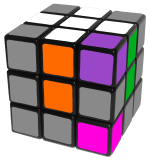
Step 3: Middle Layer Edges
Yous're 1/3 washed (kinda)! Yous're done with all white pieces, so you can now flip your cube so white is on the bottom.
Look for an border that is on the superlative face and doesn't have yellow on information technology. There'due south a very pocket-size chance that there won't be any, but in that location are instructions for that example below. Perform a U move and then that the color on the front end face of the edge is matching with the centre. In that location are two directions that the edge could go, left or correct.
Left:

If the edge needs to go in the gap to the left of it perform the following algorithm:
U' L' U Fifty U F U' F'
Right:

If the border needs to go in the gap to the right of it do this:
U R U' R' U' F' U F
If there are no more edges left on the acme layer, then they are probably either inserted in the right place but flipped, or inserted in the wrong place. To get an border out of somewhere it shouldn't exist, just insert 1 of the yellow edges into that slot. This should get the edge out and on the top layer, ready for you to use the above instructions to insert correctly.
Repeat this procedure for all four middle edges.
Step 4: Yellowish Cantankerous
Nosotros're about there now. 2/3 of the puzzle is solved, and every piece left to be solved has yellow on it somewhere. That's a expert sign… correct?
Nosotros're going to solve the top layer edges in two steps. In this step will orient all of the pieces and then that the yellow face is facing upwards for all of them. The next will move these pieces around and thus solve the cube.
Ignore the corners for now. You want to look at the edges only. Either none, all, or two of the edges will already be oriented correctly (the xanthous part is facing up).
These are the four possible edge positions that you tin can take:

Do this to transfrom to the adjacent state: F R U R' U' F'
If the edges are solved in a plus shape similar the cantankerous we made at the start (the terminal prototype), y'all can skip this phase.
Beside the solved cross y'all tin likewise have a"Dot", an "L" shape or a "Line" equally pictured higher up. To transform the Magic Cube from one state to the other, you have to apply the following short algorithm, watching out for the L shape and the line to be positioned equally required:
F R U R' U' F'
If you are in a hurry yous can speed upward the process past doing ii jumps at one time with this:
F U R U' R' F'
When you have an "L" shape, where the two yellow pieces showing are adjacent ane another. Do the required number of U or U' moves to become this 50 as shown in the motion-picture show: the corner that the two edges trap needs to be in the tiptop left. And then perform this algorithm:
F U R U' R' F'
If done correctly, you should now be looking at the xanthous cantankerous.
The third image shows the "Line" shape, where the ii yellow pieces showing are opposite 1 another. Make certain that the xanthous bar (the ii edges and the heart sticker) is horizontal, then exercise:
F R U R' U' F'
You should now be looking at four edges all oriented correctly.
For the "Dot" example shown in the start picture, just do either of these algorithms to get a different instance.
Stride five: Sune and Antisune
Sune is a very simple algorithm that many puzzlers honey due to its simplicity compared to other algorithms that they may take had to learn. In that location are vii different corner positions possible after you have oriented the edges. Sune and Antisune are two of these, simply we won't always get them straight away.
Refer to the epitome to run into what they await like. Both Sune and Antisune have one correctly oriented corner. You might have two corners oriented or none oriented. If you have all four already facing upwards, you don't need this step.
To become to the case where you but accept one oriented corner, echo the following algorithm:
R U R' U R U2 R'
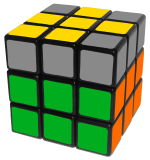
When you somewhen get the desired position, at that place are two slightly different variations of information technology. For this, nosotros demand to expect at the forepart of the cube. The yellow corner facing the front can be in 2 positions: Either facing the front, or facing the right. In the first image, it is facing the forepart. This shows you have Sune. To solve it, simply practice the in a higher place algorithm i more time, and yous should take oriented all of the top layer.
Antisune is indicated when the corner facing the right, equally shown in the second picture show:
U2 R U2 R' U' R U' R'
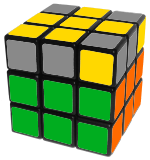
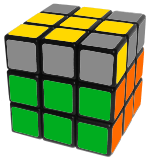
Sune and antisune
Step 6: Finishing the puzzle
We're nearly there! Last part at present.
Here, we're looking at the colours that aren't solved. In that location are 21 different cases for the top layer, but we but need a couple of algorithms to solve them all. The outset thing we want to find is headlights. Only 2 of the cases don't have any headlights (one of them is if you skip this step, and the cube is already solved). For the one instance without headlights, just perform the algorithm beneath from whatsoever bending. This is a better example because when you do the next step, the cube will be solved already.
Headlights are fairly elementary to spot. Looking at the image, we can come across on the right hand side that the orangish border has a greenish corner on either side of it. That is a prepare of headlights. The left hand side has two different colours on either side, so that is non a set of headlights. It is very important to note that a full bar (a blue edge has a blue corner on either side of it, and so all three pieces are blue) is likewise seen every bit a set of headlights. This is simply seen in one case of the 21 though, so you won't see information technology oftentimes. If you lot have a set of headlights on each side, ignore this function and read the department titled "The U Permutation".

Headlights: 2 corners having the same colour on ane side
You want to hold the cube so that the set of headlights is facing away from yous (exercise the required number of U moves so that the headlights aren't on the front, left or right). Then, do the following algorithm:
R' F R' B2 R F' R' B2 R2
You lot should at present have either a solved cube or a pair of headlights on all sides.
The U Permutation
There are 5 different positions your cube can be in at present, one of which could be solved. The residue of them accept all four corners solved, and so do the required corporeality of U moves so that every corner is in its right place. 2 of the iv remaining possibilities have a solved bar (as mentioned in a higher place, where all 3 colours on that side are the aforementioned), and the other 2 have no solved bars.
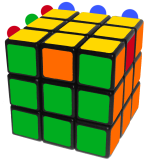
If you lot have a solved bar, put it at the back and do this algorithm:
R U' R U R U R U' R' U' R2
If your cube isn't solved, do it one more than time, making sure the bar is nevertheless at the back.
If you don't have a solved bar, do the same algorithm from whatever bending. This will leave you with a solved bar, so y'all tin can do the above.
Congratulations! You've solved the Rubik's Cube. Wasn't that hard, was it?
This tutorial didn't help y'all?
Read the beginner's Rubik's guide or go to the Rubik'south Cube solver and permit the program calculate the solution for you.
wigginsfrocceptere.blogspot.com
Source: https://rubiks-cube-solver.com/how-to-solve/
0 Response to "how to draw rubik's cube 3d drawings"
Post a Comment